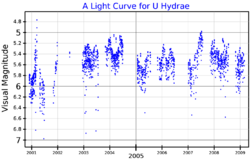Astronomy:U Hydrae
| Observation data Equinox J2000.0]] (ICRS) | |
|---|---|
| Constellation | Hydra |
| Right ascension | 10h 37m 33.27295s[2] |
| Declination | −13° 23′ 04.3529″[2] |
| Apparent magnitude (V) | 4.89[3] |
| Characteristics | |
| Evolutionary stage | AGB[4] |
| Spectral type | C-N5 C2 5-[5] |
| B−V color index | 2.80±0.51[3] |
| Variable type | SRb[6] |
| Astrometry | |
| Radial velocity (Rv) | −25.8±1.7[7] km/s |
| Proper motion (μ) | RA: +42.59[2] mas/yr Dec.: −37.72[2] mas/yr |
| Parallax (π) | 4.80 ± 0.23[2] mas |
| Distance | 680 ± 30 ly (208 ± 10 pc) |
| Absolute magnitude (MV) | −1.70[3] |
| Details | |
| Mass | 0.75[4] M☉ |
| Radius | 96.0+9.1 −16.5[8] R☉ |
| Luminosity | 3,476[4] L☉ |
| Surface gravity (log g) | −0.28[4] cgs |
| Temperature | 3,200[4] K |
| Metallicity [Fe/H] | −0.1[9] dex |
| Other designations | |
| Database references | |
| SIMBAD | data |
U Hydrae is a single[11] star in the equatorial constellation of Hydra, near the northern constellation border with Sextans. It is a semiregular variable star of sub-type SRb,[6] with its brightness ranging from visual magnitude (V) 4.7 to 5.2 over a 450-day period, with some irregularity.[12] This object is located at a distance of approximately 680 light years from the Sun based on parallax.[2] It is drifting closer with a radial velocity of −26 km/s.[7]
This is a carbon-rich red giant star on the asymptotic giant branch[4] – a carbon star – with s-process elements appearing in the spectrum. It has a stellar classification of C-N5 with a carbon star class of C2 5-.[5] The star is losing mass at the rate of 1.2×10−7 M☉·yr−1, with an outflow velocity of 6.9 km/s. Technetium has been detected in the spectrum, suggesting the star has experienced a third dredge-up episode due to thermal pulses of the helium-burning shell some time within the last 100,000 years.[13]
An ultraviolet (UV) excess has been detected coming from an extended elliptical ring that surrounds this star. It has a mean angular radius of 110″ and lines up with a detached shell of dusty material that was previously detected in the infrared band. The material was most likely ejected from the star due to mass loss episodes. The probable cause of the UV emission is from the movement of the star through space and possibly shock-excited molecules of H2. The emission does not show a bow-shock-like structure.[14]
References
- ↑ "ASAS All Star Catalogue". The All Sky Automated Survey. http://www.astrouw.edu.pl/asas/?page=aasc.
- ↑ 2.0 2.1 2.2 2.3 2.4 2.5 van Leeuwen, F. (2007). "Validation of the new Hipparcos reduction". Astronomy and Astrophysics 474 (2): 653–664. doi:10.1051/0004-6361:20078357. Bibcode: 2007A&A...474..653V.
- ↑ 3.0 3.1 3.2 Anderson, E.; Francis, Ch. (2012). "XHIP: An extended hipparcos compilation". Astronomy Letters 38 (5): 331. doi:10.1134/S1063773712050015. Bibcode: 2012AstL...38..331A.
- ↑ 4.0 4.1 4.2 4.3 4.4 4.5 Rau, G. et al. (April 2017). "The adventure of carbon stars. Observations and modeling of a set of C-rich AGB stars". Astronomy & Astrophysics 600: 21. doi:10.1051/0004-6361/201629337. A92. Bibcode: 2017A&A...600A..92R.
- ↑ 5.0 5.1 Barnbaum, Cecilia et al. (1996). "A Moderate-Resolution Spectral Atlas of Carbon Stars: R, J, N, CH, and Barium Stars". Astrophysical Journal Supplement 105: 419. doi:10.1086/192323. Bibcode: 1996ApJS..105..419B.
- ↑ 6.0 6.1 Samus, N. N. et al. (2017). "General Catalogue of Variable Stars". Astronomy Reports. 5.1 61 (1): 80–88. doi:10.1134/S1063772917010085. Bibcode: 2017ARep...61...80S.
- ↑ 7.0 7.1 Gontcharov, G. A. (November 2006). "Pulkovo Compilation of Radial Velocities for 35495 Hipparcos stars in a common system". Astronomy Letters 32 (11): 759–771. doi:10.1134/S1063773706110065. Bibcode: 2006AstL...32..759G.
- ↑ Brown, A. G. A. (August 2018). "Gaia Data Release 2: Summary of the contents and survey properties". Astronomy & Astrophysics 616: A1. doi:10.1051/0004-6361/201833051. Bibcode: 2018A&A...616A...1G. Gaia DR2 record for this source at VizieR.
- ↑ Lambert, David L. et al. (October 1986). "The Chemical Composition of Carbon Stars. I. Carbon, Nitrogen, and Oxygen in 30 Cool Carbon Stars in the Galactic Disk". Astrophysical Journal Supplement 62: 373. doi:10.1086/191145. Bibcode: 1986ApJS...62..373L.
- ↑ "U Hya". SIMBAD. Centre de données astronomiques de Strasbourg. http://simbad.u-strasbg.fr/simbad/sim-basic?Ident=U+Hya.
- ↑ Eggleton, P. P.; Tokovinin, A. A. (September 2008). "A catalogue of multiplicity among bright stellar systems". Monthly Notices of the Royal Astronomical Society 389 (2): 869–879. doi:10.1111/j.1365-2966.2008.13596.x. Bibcode: 2008MNRAS.389..869E.
- ↑ Monks, Neale (2010). Go-To Telescopes Under Suburban Skies. Springer. p. 65. ISBN 978-1-4419-6851-7. https://books.google.com/books?id=waO6tUtfblsC&pg=PA65.
- ↑ Izumiura, H. et al. (April 2011). "Extended dust shell of the carbon star U Hydrae observed with AKARI". Astronomy & Astrophysics 528: 14. doi:10.1051/0004-6361/201015163. A29. Bibcode: 2011A&A...528A..29I.
- ↑ Sanchez, Enmanuel et al. (January 2015). "First Detection of Ultraviolet Emission from a Detached Dust Shell: Galaxy Evolution Explorer Observations of the Carbon Asymptotic Giant Branch Star U Hya". The Astrophysical Journal Letters 798 (2): 5. doi:10.1088/2041-8205/798/2/L39. L39. Bibcode: 2015ApJ...798L..39S.
 |


